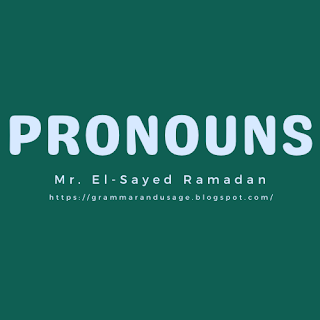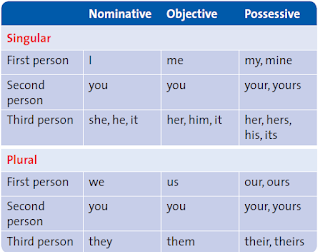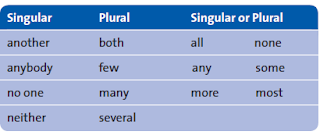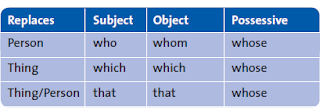Pronouns
A pronoun is a word that is used in place of a noun or another pronoun. The word or word group to which the pronoun refers is called its antecedent.
PERSONAL PRONOUNS
Personal pronouns change their form to express person, number, gender, and case. The forms of these pronouns are shown in the following chart.
AGREEMENT WITH ANTECEDENT
1-Pronouns should agree with their antecedents in number, gender, and person.
2-If an antecedent is singular, use a singular pronoun.
EXAMPLE:
- Malcolm waved as he boarded the bus to the airport.
3-If an antecedent is plural, use a plural pronoun.
EXAMPLES:
- Malcolm and Hal shared a sandwich as they waited to board the plane.
- Delores and Arnetta rode their bikes to the park.
4-The gender of a pronoun must be the same as the gender of its antecedent.
EXAMPLES:
- William will give his final performance tonight.
- Marla played her trumpet.
5-The person of the pronoun must be the same as the person of its antecedent. As the chart in Section 2.1 shows, a pronoun can be in first-, second-, or third-person form.
EXAMPLE:
- You classical music fans still have time to buy your tickets.
PRONOUN CASE
Personal pronouns change form to show how they function in sentences. Different functions are shown by different cases. The three cases are nominative, objective, and possessive. For examples of these pronouns, see the chart in Section 2.1.
1-A nominative pronoun is used as a subject or a predicate nominative in a sentence.
2-An objective pronoun is used as a direct object, an indirect object, or the object of a preposition.
3-A possessive pronoun shows ownership. The pronouns mine, yours, hers, his, its, ours, and theirs can be used in place of nouns.
EXAMPLE:
- This book is mine.
The pronouns my, your, her, his, its, our, and their are used before nouns.
EXAMPLE:
- This is my book.
WATCH OUT!
Don’t confuse the possessive pronouns its and their with the contractions it’s and they’re.
TIP
To decide which pronoun to use in a comparison, such as “He runs faster than (I or me),” fill in the missing word(s): He runs faster than I do.
REFLEXIVE AND INTENSIVE PRONOUNS
These pronouns are formed by adding -self or -selves to certain personal pronouns. Their forms are the same, and they differ only in how they are used.
A reflexive pronoun follows a verb or preposition and reflects back on an earlier noun or pronoun.
EXAMPLES:
- He likes himself too much.
- Kiyoko treated herself to dessert.
Intensive pronouns intensify or emphasize the nouns or pronouns to which they refer.
EXAMPLES:
- The merchants themselves enjoyed sampling the foods.
- You did it yourself.
WATCH OUT!
Avoid using hisself or theirselves. Standard English does not include these forms.
- NONSTANDARD: The children sang theirselves to sleep.
- STANDARD: The children sang themselves to sleep.
RECIPROCAL PRONOUNS
Reciprocal pronouns express mutual actions or relationships between the members they represent. Reciprocal pronouns also take the possessive forms each other’s and one another’s.
EXAMPLES:
- The children exchanged gifts with one another.
- Sean and Julie laughed at each other’s jokes.
DEMONSTRATIVE PRONOUNS
Demonstrative pronouns point out things and persons near and far.
Indefinite pronouns do not refer to specific persons or things and usually have no antecedents. The chart shows some commonly used indefinite pronouns.
Indefinite pronouns that end in one, body, or thing are always singular.
INCORRECT:
- Everyone brought their clarinet.
- Everyone brought his or her clarinet.
If the indefinite pronoun might refer to either a male or a female, his or her may be used to refer to it, or the sentence may be rewritten.
EXAMPLES:
- Did everybody play his or her part well?
- Did all the students play their parts well?
INTERROGATIVE PRONOUNS
An interrogative pronoun tells a reader or listener that a question is coming. The interrogative pronouns are who, whom, whose, which, and what.
EXAMPLES:
- Who wrote that song?
- From whom did you get the answer?
TIP
Who is used as a subject, whom as an object. To find out which pronoun you need to use in a question, change the question to a statement.
QUESTION:
- (Who/Whom) are you speaking to?
STATEMENT:
- You are speaking to (?).
Since the verb has a subject ( you), the needed word must be the object form, whom.
EXAMPLE:
- Whom are you speaking to?
WATCH OUT!
A special problem arises when you use an interrupter, such as do you think, within a question.
EXAMPLE:
- (Who/Whom) do you think is the better singer?
If you eliminate the interrupter, it is clear that the word you need is who.
RELATIVE PRONOUNS
Relative pronouns relate, or connect, adjective clauses to the words they modify in sentences. The noun or pronoun that a relative clause modifies is the antecedent of the relative pronoun. Here are the relative pronouns and their uses.
Often short sentences with related ideas can be combined by using a relative pronoun to create a more effective sentence.
SHORT SENTENCE:
- Joan Aiken decided to become a writer at an early age.
- Joan Aiken’s father was a poet.
COMBINED SENTENCE:
- Joan Aiken, whose father was a poet, decided to become a writer at an early age.
PRONOUN REFERENCE PROBLEMS
The referent of a pronoun should always be clear. Avoid problems by rewriting sentences.
An indefinite reference occurs when the pronoun it, you, or they does not clearly refer to a specific antecedent.
UNCLEAR:
- In the article, it claims that the new Pink Blur CD is terrific.
CLEAR:
- The article claims that the new Pink Blur CD is terrific.
A general reference occurs when the pronoun it, this, that, which, or such is used to refer to a general idea rather than a specific antecedent.
UNCLEAR:
- Trudy practices the guitar every day. This has improved her playing.
CLEAR:
- Trudy practices the guitar every day. Practicing has improved her playing.
Ambiguous means “having more than one possible meaning.” An ambiguous reference occurs when a pronoun could refer to two or more antecedents.
UNCLEAR:
- Jeb talked to Max while he listened to music.
CLEAR:
- While Jeb listened to music, he talked to Max.





